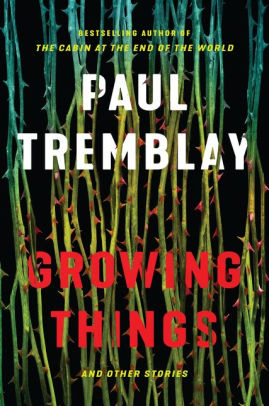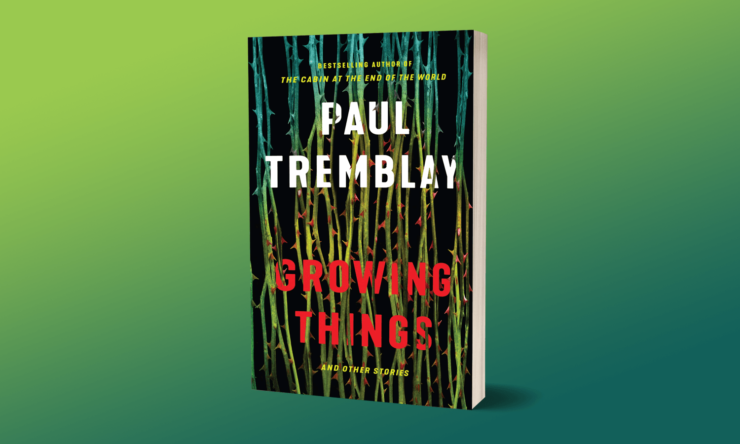Paul Tremblay’s fiction gets inside your head—sometimes literally: his novel A Head Full of Ghosts is about what may or may not be a demonic possession, and The Cabin at the End of the World centers around a home invasion by a quartet of people who may be menacing invaders, or who may be on a desperate mission to prevent the apocalypse. Tremblay’s fiction pulls off the difficult task of making the ambiguous scary: rather than show you a monster or demon, he creates the barest hint of one, offers an equally compelling mundane explanation, and allows the reader to grapple with which one is more terrifying in its implications.
His latest book is a story collection, Growing Things. In its range and assortment of techniques, it’s Tremblay’s most ambitious book; it’s also a work that abounds with references to his other novels, although prior knowledge of them is not required to make sense of these. (With perhaps one exception, which we’ll get to in a moment.) Given the range showcased here, it may not be quite as successful as some of his other books—The Cabin at the End of the World was, for me, one of the most unsettling novels I’ve read in years—but it’s still got plenty of kick.
For those familiar with Tremblay’s other work, it will come as no surprise to hear that he excels at describing something ominous and just out of reach. “It’s Against the Law to Feed the Ducks” begins with a family going on vacation, but quickly takes a bleaker twist. The story is told from the perspective of a child, who’s dimly aware that his parents are very concerned with something happening elsewhere in the world—something that’s forever changed their way of life. It’s a narrative taking place in the margins of a grander, more overtly horrific narrative. But it’s also a sly exploration of morality: the title refers to a sign encountered near a beach, but it begins to reflect something greater. In the presence of a crumbling society, to what extent do societal mores still matter? Is it still illegal to feed the ducks if no one’s around to enforce it?
Buy the Book


Growing Things
The title story, about two sisters navigating strange plant life and some uncomfortable truths about their family, also benefits from a similar restricted perspective. (There’s a connection here to Tremblay’s novel A Head Full of Ghosts, though story and novel both stand on their own just fine.) And “Notes for ‘The Barn in the Wild” makes deft usage of a metafictional found-objects structure: it’s presented as the journal of a writer on the trail of a student who encountered an unfortunate fate. The journal’s author is in search of material for the next Into the Wild, but what he encounters suggests a work that might be filed a few shelves over, under “Horror.” Or perhaps “Waking Nightmares.”
Tremblay’s use of a “found” document, footnotes, and occasional blocks of crossed-out text make for the most memorable use of textual experimentation here. “A Haunted House is a Wheel Upon Which Some Are Broken” offers readers multiple paths through the narrative, while “Further Questions for the Somnambulist” is structured in a particularly ornate way, with three columns of text. Both do a fine job of instilling a sense of dread, but don’t unnerve quite as well as some of their neighbors in this book. “Notes From the Dog Walkers” is structured as, well, a series of notes from dog walkers—but it gradually takes on a sinister cast, utilizing misdirection and metafiction in equal measures.
As he reminds the reader in a selection of notes about these stories at collection’s end, Tremblay’s first few books fell more under the heading of crime fiction than horror. And when he opts to, he can still deliver a sustained sense of alienation ending in a gut-punch of an ending that’s as tense as any account of a heist or murder. “______,” about a man whose wife is replaced by someone else, is constantly unnerving, while “The Getaway,” in which the participants in a robbery find themselves targeted by a mysterious and supernatural force, plays out in a terrifying manner.
Growing Things exists in a strange liminal state: in certain places, it links up with Tremblay’s larger bibliography, and gives a fine sense of his recurring themes and images. But it’s also a showcase for his range as an author, and a place for him to experiment with things that might not click on the scale of a longer work. There’s plenty to applaud here, but even more to send readers shivering—a fine blend of technique and terror.
Growing Things is available from William Morrow.
 Tobias Carroll is the managing editor of Vol.1 Brooklyn. He is the author of the short story collection Transitory (Civil Coping Mechanisms) and the novel Reel (Rare Bird Books).
Tobias Carroll is the managing editor of Vol.1 Brooklyn. He is the author of the short story collection Transitory (Civil Coping Mechanisms) and the novel Reel (Rare Bird Books).










